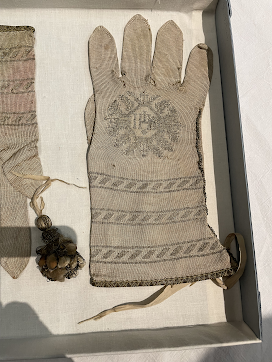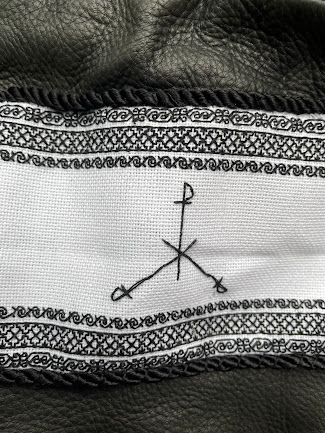Set of gloves #1
The first set of gloves I examined at the MFA is the pair from 16th century Spain.
They are a fairly large pair, measuring 11 inches by 5 1/inches.
There is a large medallion design on the back of each hand with the letters IHS- a Jesuit symbol.
The fingers and thumb are unadorned with a fairly simple offset striping pattern repeated on the cuff.
One interesting design aspect of this set is that it is seamed up the outside edge and the seam is covered up with a twisted ribbon edging. By looking at the inside of the glove, it appears that the edging and the seams are sewn together with a linen thread.
The bottom edge of the gloves are finished with a metallic trim, folded in half and sewn down, again with the linen thread. There are also large tassels that came with this set- one attached via silk ribbon and one detached.
The gloves are fully lined in silk- originally white, I would surmise, but now age-faded to an ivory/taupe color.
The body of the gloves are knit in the round up to the bottom of the thumb. I see a clear line showing a change in tension in the stitches which could indicate where the stitches were picked up to complete the thumb. The same line of tension is visible at the base of the fingers, possibly indicating that each finger was completed individually.
For the ends of the thumbs, it looks like the stitches were decreased in a regular pattern, resulting in a final 4 stitches across the tip.
The fingers, in comparison, appear to have been knit in the round until the final half inch before there was decreases in a straight line. Each fingertip seems to finish with 3 stitches across.
There are several repairs that have been done on the gloves with linen thread instead of the same silk yarn that was used to create the gloves. I’m not sure if this is because the repairs were done within the household instead of sending the gloves back to the knitting guild which created them.
The director at the MFA lent me a lighted loupe which showed 8 stitches to every 10 millimeters with what looks like three strands of silk plied together to form the yarn.
I'm intrigued by the differences in the four sets of gloves and am curious to see if I can discover if there are regional reasons, separate guilds or another reason for the disparities in construction.
As an aside, I have a theory about the knitting guilds in Spain during the 15th to 17th centuries. I want to see if I can uncover the truth, but to my way of thinking, apprentices wouldn't be given the expensive silk to work with to develop their skills. Instead, I am theorizing that apprentices would be given wool to start with-- likely Merino as it's a Spanish breed. Journeymen would be using a silk/wool blend to start becoming familiar with silk as it knits/handles very differently from the elasticisity of wool. Masters alone would be working with 100% silk to create the ecclesastical gloves for the bishops.











Hey, Gracie - love the details you've got here!
ReplyDeleteI think that your stitch gauge is showing 10mm, though - not 10cm. The bottom seems to be fractions of an inch and 3/8 inch would be about 9mm. VERY different scale. :-)